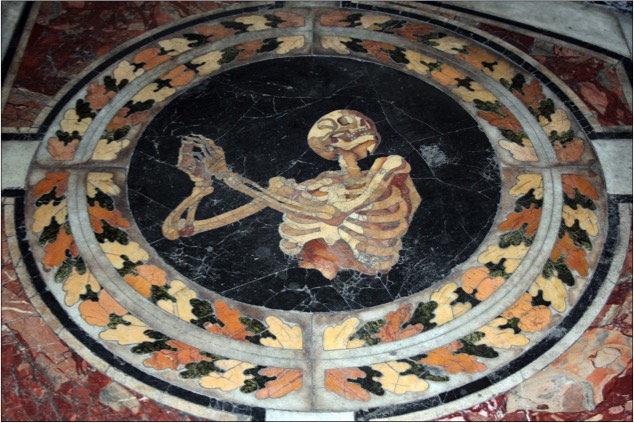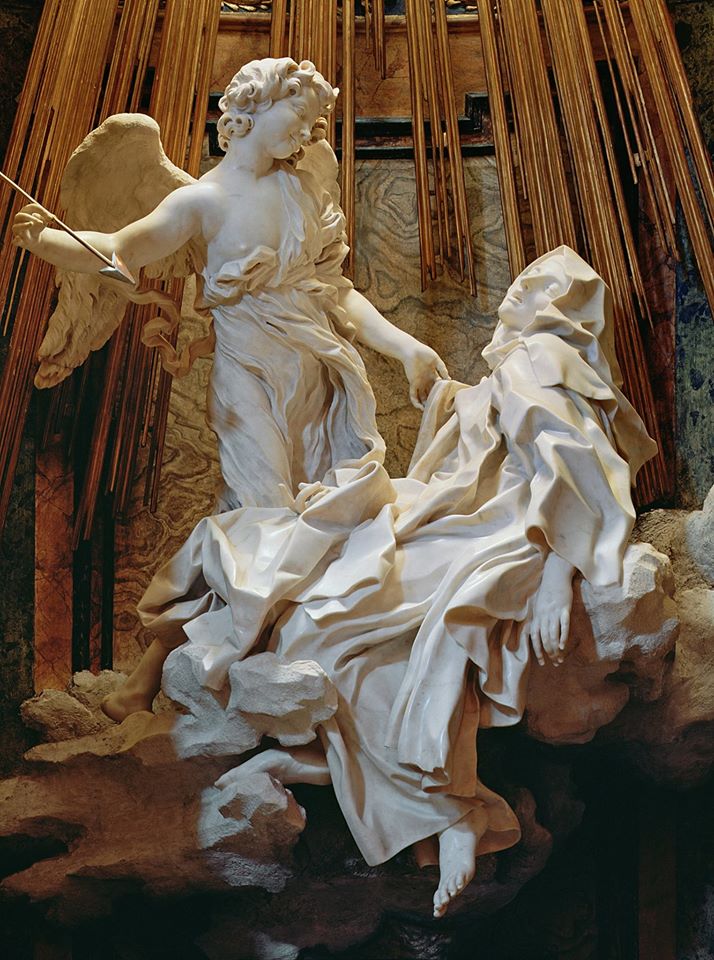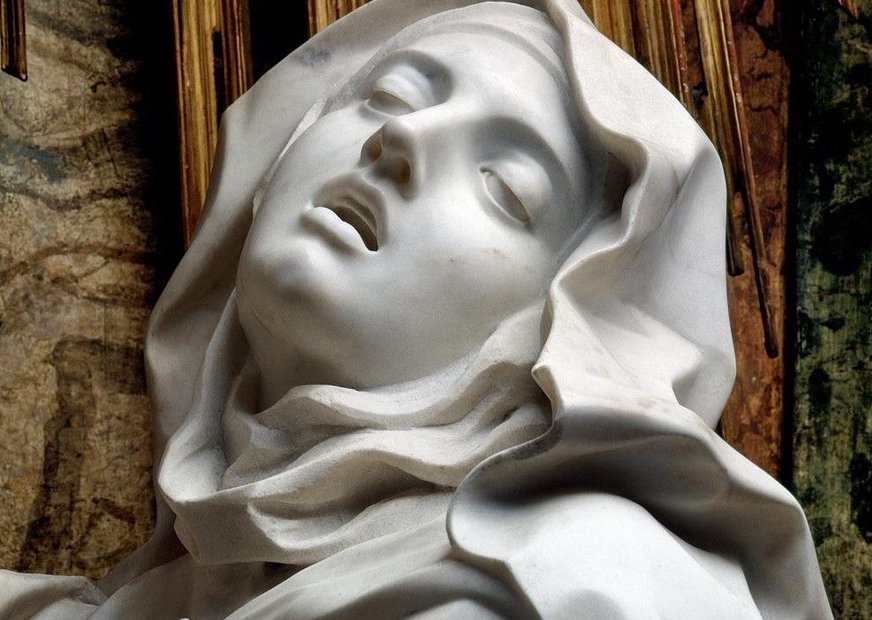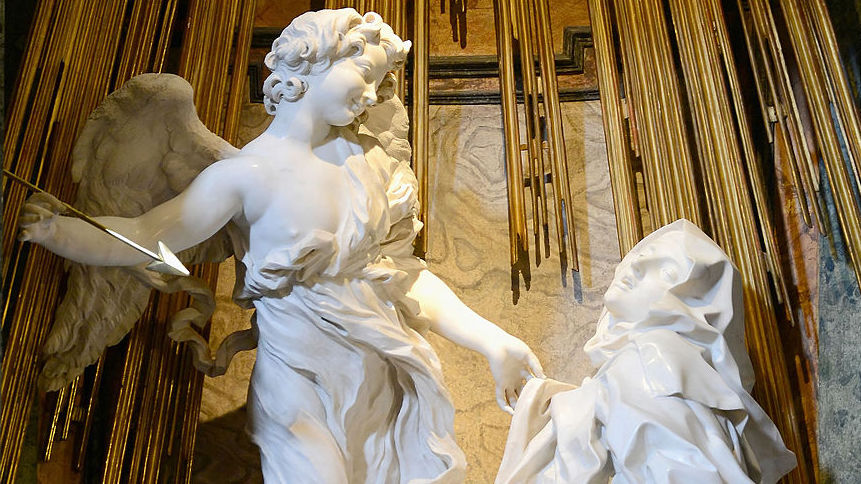Gian Lorenzo Bernini, The Ecstasy of St Theresa, 1647-52, Santa Maria della Vittoria, Rome.
I’ve said it before: the Baroque is theatrical. Well, the audience is gathering…


Already the Cornaro family have bagged the best spots in the boxes on either side of the stage – those Venetians like a bit of theatre. They are the relatives of Cardinal Federico Cornaro, who was Patriarch of Venice from 1631 until 1644, which is when he resigned the post, and participated in the conclave which elected Pope Innocent X. Unlike Popes before and after, Innocent didn’t like Bernini, leaving the artist free to work for Cornaro, who commissioned his funerary chapel in 1647. It took five years to finish, which fortunately wasn’t too long: Cornaro died the year after completion. He’s second from the right on the right hand side. Bernini smartly gets him to chat to the person on his left – so he is looking out towards us, and we can see him better than any other figure.

The audience are seated, as I said, although others have taken to the air. Bernini was a master of Gesamtkunstwerk, a German word meaning ‘all the arts together’: sculpture, architecture and painting all contribute to this ensemble, and Bernini was a dab hand at each. Not that he had to do all three by this stage in his career, as he had a vast workshop with many assistants, and they’ve really raised the roof for this one. We can see the Holy Spirit descending in a glory of golden light, surrounded by the heavenly host, who are flying in or already in attendance, floating on the clouds which cover the vault and even obscure part of the window. The entrance arch to the chapel is also thronging with angels, modelled in stucco (a form of plaster).

There is even another audience member looking up from the pit: a skeleton raising its hands in prayer, reminding us that this is, after all, a funerary chapel. Its gesture – with hands together but elbows apart, was one which Bernini used to create interesting views when you were likely to get a number of different views of a sculpture – but it works equally well to create a sculptural effect here – particularly as the hands go to our left, while the skeleton looks up to our right, remarkably vivacious for one so dead. Maybe this is intended not only as a memento mori but also as a memento resurrectionis (or whatever that would be in Latin). The pietra dura, or ‘hard stone’, inlay of the pavement adds to all the other materials on view – from the stained glass, the frescoed ceiling, the stucco angels and the polychrome marble architecture, to the white Carrara marble sculptures. Don’t make the mistake of thinking of this as just a sculpture – it is far more than that: it is everything. But where do we fit in? With the boxes, the gods and the pit already taken, where do we find a space to watch the spectacle? Where else but the orchestra stalls.

So here we are, looking up to the drama itself. Bernini has already drawn back the curtain, and through the proscenium arch we see a woman reclining on a cloud, and a young man with wings holding a golden arrow. If we weren’t in a church you would swear he was Cupid. Some people still swear, to be honest. Bernini seems to have created a bubble in reality, the pairs of twinned columns supporting a triangular pediment which curves out towards us, while the back wall of this visionary space curves away. A supernatural light streams down from above along golden beams of light. If you are patient, you can even find a place in the front row.


This vision we are witnessing is part of a sculptural – or even architectural – altarpiece. Its function is made clear by the relief of the Last Supper on the front of the altar itself: this is where the Mass, as instituted at the Last Supper, is performed. And here, it would have been a funerary mass, performed for the soul of Federico Cornaro. The relief is cast in gilded bronze – two more materials that Bernini has brought into play. The members of the Cornaro family on either side are effectively donor portraits, familiar from many Renaissance paintings, but given new life, as they now have solid form. The angel is young, and smiles down at St Theresa, holding the arrow delicately in his right hand, while lifting her robe with his left. She seems unaware of his presence, eyes closed – or almost closed – lips parted, left hand and foot hanging down from the edge of the cloud on which she appears to be transported in ecstasy, her right foot poised on the cloud itself. As ever with Bernini the quality of the materials is so very specific. The angel’s dress is thin, and finely wrinkled, a light cotton presumably, like the surplices worn by choir boys, although curiously off the shoulder. Her habit is thicker, with fuller, more rounded folds, the textile equivalent of her heavy limbs – my guess would be wool. The cloud looks oddly rough – but how else would you get the nebulous, formless sense of an object without substance?
St Theresa of Ávila, a visionary Spanish nun of the 16th Century, had only recently been canonised – well, only 25 years before the commission, on 12 March 1622. At the same ceremony Pope Gregory XV also welcomed St Ignatius Loyola, founder of the Jesuit order, into the Canon of Saints. Both were important for the Counter Reformation because of both their faith and their deeds. However, Gregory is sure to have had an ulterior motive. Canonising two Spanish saints the year after the 12-year truce in the 80 years war between Spain and the Protestant Netherlands had ended was surely not coincidental: he was promoting two more top rank soldiers for the Church Militant in the fight against the Protestant threat. Theresa’s visions had a number of impacts on the History of Art – but no one could have foreseen this particular sculpture as one of them. On first sight, one is left asking how Bernini could dream up such a sensuous subject for the focus of our contemplation of the Divine – but fortunately, Theresa wrote an account of her life and experiences, so we can find out for ourselves. These extracts are from David Lewis’s 1904 translation, which you can find here – you need to go to Book XXIX.
Our Lord was pleased that I should have at times a vision of this kind: I saw an angel close by me, on my left side, in bodily form… He was not large, but small of stature, and most beautiful – his face burning, as if he were one of the highest angels, who seem to be all of fire: they must be those whom we call cherubim. Their names they never tell me; but I see very well that there is in heaven so great a difference between one angel and another, and between these and the others, that I cannot explain it.
So there we have it, ‘small of stature, and most beautiful’. But then, even in heaven there is ‘so great a difference between one angel and another…’ – a statement which always reminds me of Goneril’s line in King Lear, spoken as her thrusting young lover Edmund departs, and just before the arrival of her rather ineffectual husband:
Oh, the difference of man and man! To thee a woman’s services are due.
But maybe that’s a distraction? There are, after all, nine choirs of angels – remind me to tell you about them another time. But why was this particular angel there? This is how the vision proceeds:
I saw in his hand a long spear of gold, and at the iron’s point there seemed to be a little fire. He appeared to me to be thrusting it at times into my heart, and to pierce my very entrails; when he drew it out, he seemed to draw them out also, and to leave me all on fire with a great love of God. The pain was so great, that it made me moan; and yet so surpassing was the sweetness of this excessive pain, that I could not wish to be rid of it.

And this is the ecstasy in which we see her, the angel about to thrust, and she, moaning at the sweetness of the excessive pain. On seeing the sculpture in 1739 the French connoisseur Charles de Brosses cynically remarked, ‘If that is divine love, then I know it well’. I can see his point, and yet… the couple float so miraculously, they seem suspended in stasis outside of our world, protected by the architectural forms that wrap around them, holding them in an embrace, lit by the magical, manipulated light: they are divine. Yet we are allowed to see them, witnessed as they are by sculptural donors, carved and painted angels, and a pietra dura skeleton. We too have our place, transfixed along the altar rail. The last word goes to Theresa:
The soul is satisfied now with nothing less than God. The pain is not bodily, but spiritual; though the body has its share in it, even a large one. It is a caressing of love so sweet which now takes place between the soul and God, that I pray God of His goodness to make him experience it who may think that I am lying.


Thank you Richard, that blog gave me so much pleasure and happy memories.I agree with the comment of de Brosses though not with his cynicism . I just think that Bernini created the most beautiful and sensual vision of ecstasy that I have ever seen and you have brought it all back to me including the sheer delights of that marvellous first dilettante escapade. X, Rory
LikeLiked by 1 person
Thank you – I wish I’d been there with you and Robert back then!
LikeLike
Like the others. – a huge thank you. When I opened our Blue Guide to Rome I found a postcard of ‘L’estasi di S. Teresa’ marking a page. Reminding me of a wonderful guided pre-millennium visit with Luca Leontini. How lucky we are to have people like you and him to immortalise these treasures for us.
LikeLiked by 1 person
My pleasure – thank you.
LikeLike
I always spend some time with St Theresa when I am in Rome! All that baroque theatre! Last time I was there I inadvertently gatecrashed a wedding, which added something to one’s thoughts on earthly and divine ecstasy!
JudithNash
LikeLike
How wonderful – it is the place for things to happen… and I’ve had experiences from the sublime to the ridiculous. But another time for all that!
LikeLike
“I can see his point, and yet… the couple float so miraculously, they seem suspended in stasis outside of our world, protected by the architectural forms that wrap around them, holding them in an embrace, lit by the magical, manipulated light: they are divine. Yet we are allowed to see them, witnessed as they are by sculptural donors, carved and painted angels, and a pietra dura skeleton. We too have our place, transfixed along the altar rail.” This is beautiful writing, Richard. I particularly love the way you have drawn our eye to the framing of the scene BEFORE you take us to Theresa herself. When I compare the way you have written about and shown us this piece, to Schama’s shameless voyeurism, your incredible ability to preserve the dignity and intimacy of the act of watching enables us to discern ecstasy as a psychoerotic experience, yes, but the transcendent experience that St Theresa tries to describe, and Bernini seeks to convey. It’s all in the framing. Brava.
LikeLiked by 1 person
Thank you – but really, too kind!
LikeLike